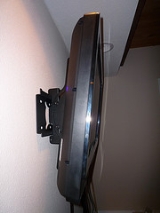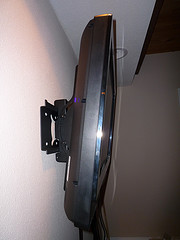
Flat Display Mounting Interface
Encyclopedia
The Flat Display Mounting Interface (FDMI), also known as VESA Mounting Interface Standard (MIS) or colloquially as VESA mount, is a family of standards defined by the Video Electronics Standards Association for mounting flat panel monitor
s, TVs, and other displays to stands or wall mounts. It is implemented on most modern flat-panel monitors and TVs.
The first standard in this family was introduced in 1997 and was originally called Flat Panel Monitor Physical Mounting Interface (FPMPMI).
The MIS-D screw holes have an M4
thread and are typically 10 mm deep. Appropriate fasteners (typically ~10 mm long) are often supplied with the mount rather than the display, but they are also easily available from many hardware stores.
The FDMI was extended in 2006 with a collection of additional screw patterns that are more appropriate for larger TV screens.
 Examples of the full identification of a particular FDMI variant look like
Examples of the full identification of a particular FDMI variant look like
where
Computer display
A monitor or display is an electronic visual display for computers. The monitor comprises the display device, circuitry, and an enclosure...
s, TVs, and other displays to stands or wall mounts. It is implemented on most modern flat-panel monitors and TVs.
The first standard in this family was introduced in 1997 and was originally called Flat Panel Monitor Physical Mounting Interface (FPMPMI).
Variants
The original VESA mount (MIS-D) consisted of four screws arranged in a square, with the horizontal and vertical distance between the screw centers being 100 mm. This is still the most commonly used configuration for desktop computer displays. A 75 mm × 75 mm layout was defined for smaller displays.The MIS-D screw holes have an M4
ISO metric screw thread
The ISO metric screw threads are the world-wide most commonly used type of general-purpose screw thread. They were one of the first international standards agreed when the International Organization for Standardization was set up in 1947.-Basic profile:...
thread and are typically 10 mm deep. Appropriate fasteners (typically ~10 mm long) are often supplied with the mount rather than the display, but they are also easily available from many hardware stores.
The FDMI was extended in 2006 with a collection of additional screw patterns that are more appropriate for larger TV screens.
| MIS-D 75 | 75 mm × 75 mm | M4 |
| MIS-D 100 | 100 mm × 100 mm | M4 |
| MIS-E | 200 mm × 100 mm | M4 |
| MIS-F | 200 mm × 200 mm 400 mm × 400 mm 600 mm × 200 mm 600 mm × 400 mm 800 mm × 400 mm 280 mm × 150 mm |
M6, M8 |

- VESA MIS-D, 100, C
- VESA MIS-F, 200, 200, 6
where
- the letter after MIS- identifies the part of the standard used, e.g.
- part B, C, D, E for flat displays with 10–78 cm diagonal
- part F for flat displays with 79–230 cm diagonal
- for part D, a number identifies the 75 mm and 100 mm variants (100 or 75),
- for part F, a number pair identifies the maximum width and height of the mounting-hole pattern,
- for parts B–E, a final letter identifies the interface location on the flat display as center (C), top (T), bottom (B), left (L), right (R), top and bottom (T/B), or left and right (L/R),
- for part F, a final digit distinguishes between 10 mm deep M6ISO metric screw threadThe ISO metric screw threads are the world-wide most commonly used type of general-purpose screw thread. They were one of the first international standards agreed when the International Organization for Standardization was set up in 1947.-Basic profile:...
mounting holes (6) and 15 mm deep M8ISO metric screw threadThe ISO metric screw threads are the world-wide most commonly used type of general-purpose screw thread. They were one of the first international standards agreed when the International Organization for Standardization was set up in 1947.-Basic profile:...
holes (8).

